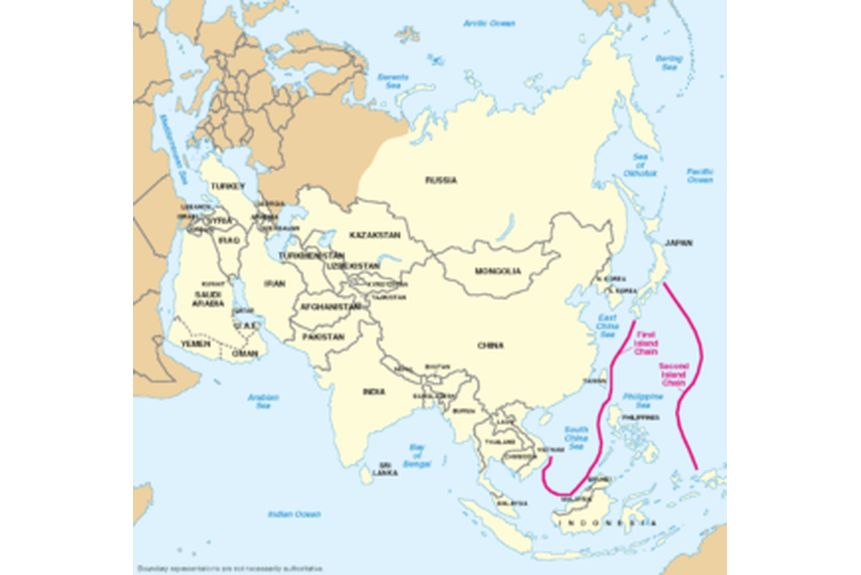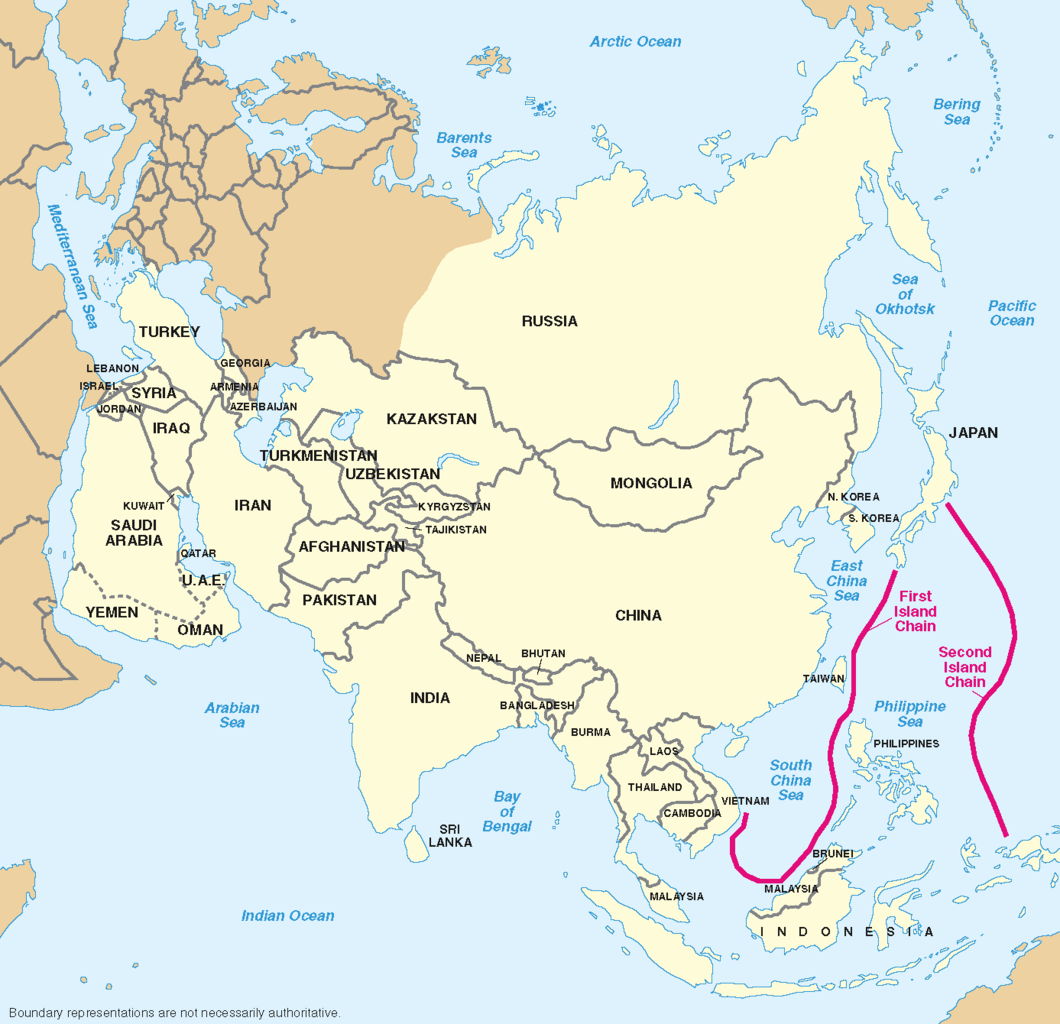
China’s Attempt To Increase Regional Influence
By Cindy Hurst

First and Second Island Chains
“China is attempting to erode the United States’ status as the world’s leading military power and largest economy by pushing “militarily-motivated” regional economic cooperation around the world”
Taiwan’s Ministry of National Defense (MND) wrote in a recent report that China is trying to erode U.S. military dominance and economic power through a “covert military agenda,” according to Taiwan state-run press agency Focus Taiwan. The MND bases its conclusion on several phenomena, including China’s expanding influence beyond the Second Island Chain,[i] which sees Beijing courting military allies through economic inducements. According to the article, China has pushed to establish a military base in the Solomon Islands, with which it plans to form a strategic partnership, particularly based on economics. China established official diplomatic relations with Solomon Islands in 2019, following the Solomon Islands’ cutting of ties with Taiwan. In celebrating the shift, the Chinese Foreign Ministry stated the new ties with China will bring the Solomon Islands “unprecedented development opportunities.”[ii] The article expresses concern that establishing a military base in the Solomon Islands will help China to better project power past the Second Island Chain. China is also using cognitive warfare, gray zone tactics and intimidation, to gain the upper hand over the United States. This includes deploying naval forces and maritime police and militia to interfere with freedom of navigation in the South China Sea. Recent reports, such as the second article excerpt, published in the independent Philippine Daily Tribune, underscore this reality. The article argues that China is combining lawfare[iii] and gray zone tactics to wear down its neighbors in the South China Sea and is waiting for “a suitable administration in the United States, which would give less importance to America’s stabilizing role in the Asia-Pacific region.”
Sources:
Matt Yu and Sean Lin, “China Pushing Military Agenda Behind Economic Exchanges: Defense Ministry,” Focus Taiwan (Taiwan state-run press agency), 11 October 2023. https://focustaiwan.tw/cross-strait/202310110023
China is attempting to erode the United States’ status as the world’s leading military power and largest economy by pushing “militarily-motivated” regional economic cooperation around the world, as evidenced by its plan to set up a military base in the Solomon Islands, which seeks to expand its power projection past the Second Island Chain, according to Taiwan’s Ministry of National Defense (MND).
In a report delivered to the legislature on Wednesday, the MND pointed out that China has a “covert military agenda” aimed at diminishing U.S. military dominance and economic power under its Belt and Road Initiative.
For instance, China has in recent years attempted to establish a military base in the Solomon Islands to consolidate the two countries’ strategic partnership, which is a move aimed at expanding Chinese power projection past the Second Island Chain, according to the report.
In addition, China has adopted aggressive maneuvers in an attempt to establish control over issues relating to the South China Sea, including engaging in “gray zone” activities by deploying its naval forces and maritime police and militia to interfere with other countries’ freedom of navigation in the region, the report said.
“Long-Game Scenario,” Daily Tribune (an independent Philippine daily newspaper), 17 October 2023, https://tribune.net.ph/2023/09/21/long-game-scenario/
The tactic (lawfare and grey zone) involves wearing down its opponents in the South China Sea conflict while waiting for a suitable administration in the United States, which would again give less importance to America’s stabilizing role in the Asia-Pacific region.
China’s preparations for a protracted conflict are evident in its latest moves, from making public the 10-dash line claim, the absence of Chinese President Xi Jinping from the Association of Southeast Asian Nations Summit in Jakarta, and the water spraying by a Chinese Coast Guard vessel of a Philippine Navy boat on a mission to resupply the grounded Sierra Madre.
Regional analysts said China is employing a combination of lawfare, which is the use of legal systems and institutions to undermine an opponent, and gray zone tactics, which are maneuvers short of war that point to a conflict for the long haul.China’s drafting of a new map was timed to reassert its territorial claims and flex its muscles ahead of the ASEAN and G20 Summits.
Notes:
[i] China’s Island Chain strategy is a maritime strategic concept that the country adopted in the 1980s. For most of its history, China focused on its internal and continental security issues. Then, as China began to open to the rest of the world, it recognized that to be a viable power, it would have to extend out into the maritime domain. The First Island Chain, which consists of the Kuril Islands, the Japanese archipelago, the Ryuku Islands, Taiwan, northern Philippines, and Borneo is the line of defense to which China would project power to protect, deny, and contest other strategic powers. The Second Island Chain reaches out to the Japan Bonin Islands, the Marianas, the western Caroline Islands, and Western New Guinea. The Third Island Chain is the Aleutian Islands, the center of the Pacific Ocean through Oceania, the Hawaiian Islands, American Samoa, New Zealand, and Australia. See Beatrice Heuser and Paul O’Neill, “Episode 5: Admiral Liu Huaqing and China’s Island Chain Strategy,” RUSI, 9 August 2022. https://rusi.org/podcasts/talking-strategy/episode-5-admiral-liu-huaqing-and-chinas-island-chain-strategy
[ii] “2019年9月17日外交部发言人华春莹主持例行记者会 (On September 19, 2019, Foreign Ministry Spokesperson Hua Chunying Hosted a Regular Press Conference),” Ministry of Foreign Affairs of the PRC, 17 September 2019. https://www.fmprc.gov.cn/fyrbt_673021/jzhsl_673025/201909/t20190917_5418035.shtml
[iii] Lawfare, or legal warfare, is the use of legal systems to damage or delegitimize an opponent. China is said to have the most advanced lawfare strategy, which it incorporated as a major military strategy as early as 1999. An example of China’s use of lawfare is when it drafted a new map to reassert its territorial claims and flex its muscles prior to the ASEAN and G20 Summits. Lawfare is one of China’s “Three Warfares” strategy, used to drive the country’s military influence operations. (The other two “warfares” are public opinion warfare and psychological warfare). States. See: Jill Goldenziel, “Law as a Battlefield: The U.S., China, And the Global Escalation of Lawfare,” Cornell Law Review, Vol. 106, 23 September 2021. https://www.cornelllawreview.org/2021/09/23/law-as-a-battlefield-the-u-s-china-and-the-global-escalation-of-lawfare/
Image Information:
Image: First and Second Island Chains
Source: Public domain, https://commons.wikimedia.org/wiki/File:Geographic_Boundaries_of_the_First_and_Second_Island_Chains.png
Attribution: DoD
Distribution A: Approved for public release
Categories:
Tags:







